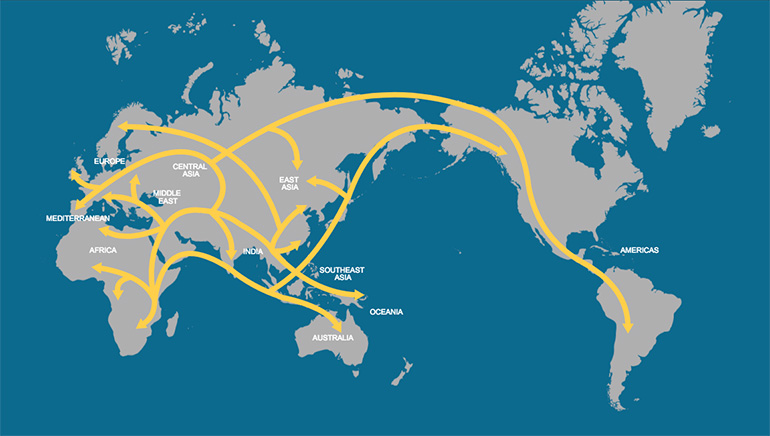
Food multiculturalism


“Our elders say we need to have our own food
to be healthy and to be who we are”
(Elder Fred Erasmus, Yellowknives Dene First Nation)
The journey of human being
The evolution and history of human being is accompanied by continual geographical shift, first out of the African cradle (about 60,000 years ago) until then colonizing all parts of the world. It is assumed that the first passage of man from Europe to America takes place between 40,000 and 15,000 years ago, through the Bering Strait, while the colonization of Australia dates back to 50,000 years ago. The great geographic discoveries and explorations occurring between the ‘400s and the’ 500s by Western civilizations open the door to important migrations, continuing to modern times.
In this shift between displacement and stanzity, man has developed a relationship with the nature and the food resources of the place that has generated over time a great diversity of forms of nutrition. Even though they come from areas very far from their place of origin, they have become food typical that have become part of the cultural identity of the land that welcomes them. Consider the tomato, originally from the Americas, which has become a vegetable garden typical of Mediterranean culture; potatoes, also coming from South America, but typical of Central and Central European cuisine.

Food is health and culture
Nowadays, we have a large number of people who travel for different reasons between countries and continents, generating important flows of migrants, refugees, workers, students and tourists. Everyone carries with them their own culture creating an exchange of food and culinary features, with a “contamination” of eating habits, both of those who move and of those who welcome them.
In Italy, like in other countries that welcome foreigners, there is growing ethnic food * with the acquisition of alternative food styles. The restaurant offer has been greatly enhanced with new proposals, sometimes modified from the original version, to meet the tastes of the host country by combining local ingredients with other importers.
* Ethnic food is the one from countries other than the host country, which contributes to a dietary culture other than the local tradition (1).
According to a recent Censis survey on Italian food purchasing in large organized distribution, it emerges that:
– 38.6 million (9.4 million on a regular basis) choose fair trade food products;
– 31.7 million (5.9 million regularly) choose ethnic products.
Better stay out of the western diet

Immigrants acquire new eating habits, adapting to the Western diet (2) with all its defects; among these remember a high consumption of refined sugars, alcohol, saturated fat, salt (sodium), refined oils and, conversely, a reduced supply of vegetable fibers, omega-3 fatty acids (in themselves and in relation to omega-6) and some micronutrients such as vitamin C.
From a survey among immigrants in Italy (data Tomorrow Swg, 2007) 62% eat in fast food and 76% go to a pizzeria or restaurant.
As already mentioned, pizza and sandwiches do not represent the healthy Mediterranean food style, but rather drift towards the so-called “Western Diet“, which is contributing to the aggravation of overweight, obesity and mortality problems for chronic degenerative diseases in Italy and in the world.
It is well-known that populations migrating to more developed countries are experiencing greater weight problems than the people in their host countries. The opposite is also documented, that the maintenance of one’s culinary traditions is associated with a lower incidence of obesity once it reaches new countries (3).
Looking for the perfect diet
Along with the scientific progress that correlate human health with “what is put in the pot” (nutrition), people are looking for the search for the perfect diet and foods with healthy properties. Many of these foods belong to Mediterranean culture, e.g. extra virgin olive oil, nuts, hazelnuts, almonds, blue fish, vegetables, fruit and berries; others belong to the category of ethnic or “forgotten” food products recently rediscovered. Among ethnic foods with particular nutritional properties we mention, for example, flax, chia, hemp seeds and their derivatives, macadamia nuts, coconut, quinoa, amaranth, avocado, edible algae, miso and other fermented soy products, milk kefir, green tea, coffee, cocoa and the varied world of spices.
Given the shortage of omega-3 fatty acids in the western diet and the unbalanced omega-6 / omega-3 ratio in favor of the early, it is important to include in the diet foods particularly rich in these precious lipids; among these are typical foods of other cultures, or that have been part of our past history such as flaxseed, hemp seeds and chia. We compare the fat content of these foods, including the values for common nuts (Table 1).
| Total FAT g/100 |
SFA g/100 |
MUFA g/100 |
PUFA g/100 |
ὠ 6 g/100 |
ὠ 3 g/100 |
Issues | |
| Flax seed |
42,16 | 3,66 | 7,53 | 28,73 | 5,90 | 22,81 | Must be milled |
| Chia seed |
30,74 | 3,33 | 2,30 | 23,66 | 5,83 | 17,83 | Very expensive |
| Hemp seed |
48,75 | 4,60 | 5,40 | 38,10 | 27,36 | 8,68 | Less ὠ 3 |
| European walnut |
65,21 | 6,12 | 8,93 | 47,17 | 38,10 | 9,10 | Less ὠ 3 |
Legend: SFA = Saturated Fatty Acid; MUFA = Monounsaturated Fatty Acid; PUFA = Polyunsaturated Fatty Acid; ὠ 6 = omega-6; ὠ 3 = omega-3.
Source: USDA United States Department of Agriculture. National Nutrient Database for Standard Reference Release 28.
In our choices, therefore, we should have a wider vision and strive for healthy eating for us and for the environment, from an ethical, sustainable point of view, and wherever possible to “km 0” (local). This does not mean exclude ethnic foods, but rather to safeguard the economy of local populations by not targeting their food predominantly to the foreign market or disincentive of high-impact crops that only meet the demands of the richest markets.
Bibliography
(1) Kwon D.Y. What is ethnic food? Journal of Ethnic Foods. Editorial. 2015.
(2) Cordain L. et al. Origins and evolution of the Western diet: health implications for the 21st century. Am J Clin Nutr 2005; 81:341–54.
(3) Renzaho A.M.N. Maintenance of traditional cultural orientation is associated with lower rates of obesity and sedentary behaviours among African migrant children to Australia. International Journal of Obesity. 2008; 32, 594–600.
Article by:
Nutritionist Dr. Francesco Bonucci
The diet tips, written in the article, are not intended to be a substitute for a personal nutrition plan and are to be adapted to specific cases.
Foto: 123RF Archivio Fotografico | ©Iryna Melnyk, 32052787, 2017-08-23 | ©Julian Rovagnati, 16582302, 2017-08-23 | ©National Geographic per la mappa illustrata
- On 25 August 2017



